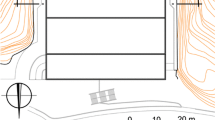Abstract
Expansion of dark mudrocks as a consequence of sulphate development has been known for many years, generally occurring in low pH conditions. In buildings in Dublin, ground floor heave of up to 48 mm has been recorded within 5 years of construction, with some properties showing signs of distress even before the completion of the development. In each case the ground-bearing floor slabs rested on a pyritiferous aggregate with a pH of 8–10. A new model is proposed to explain why the effect of the expansion was evident in such a short period of time.
Résumé
Le gonflement des argilites noires en conséquence du développement de sulfates est connu depuis de nombreuses années. Il apparaît généralement pour des faibles valeurs de pH. Dans des bâtiments à Dublin, des soulèvements de rez-de-chaussée jusqu’à 48 mm ont été enregistrés dans les cinq années suivant la construction, avec quelques caractéristiques correspondant à des situations critiques avant même l’achèvement du processus. Dans chaque cas le dallage sur terre plein reposait sur un matériau de remblai constitué de ces argilites concassées, pyriteuses, avec un pH de 8–10. Un nouveau modèle est proposé pour expliquer pourquoi les effets du gonflement ont pu se réaliser aussi rapidement.





Similar content being viewed by others
References
Fasiska E, Wagenblast N, Dougherty MT (1974) The oxidation mechanisms of sulphide minerals. Bull Ass Eng Geol 11:75–82
Hawkins AB, Pinches GM (1987a) Cause and significance of heave at Llandough Hospital, Cardiff: a case history of ground floor heave due to gypsum growth. QJEG 20:41–57
Hawkins AB, Pinches GM (1987b) Sulphate analysis on black mudstones. Geotechnique 37:191–196
Hawkins AB, Pinches GM (1992) Understanding sulphate generated heave resulting from pyrite degradation. In: Hawkins AB (ed) 1997, Ground chemistry. Implications for Construction, Balkema, pp 51–75
Hawkins AB, Wilson SLS (1990) Sulphate increase in laboratory prepared samples. QJEG 23:383–385
Nixon PJ (1978) Floor heave in buildings due to the use of pyritic shales as fill material. Chem Ind pp 160–164
Penner E, Eden WJ, Grattan Bellew PE (1972) Expansion of pyritic shales. In: Canadian building digest, vol 152. National Research Council of Canada
Penner E, Eden WJ, Gillott JE (1973) Floor heave due to biochemical weathering of shale. In: Proceedings 8th International Conference on Soil Mechanics and Foundation Engineering, vol 11. Moscow, pp 151–158
Quigley RM, Vogan RW (1970) Black shale heaving at Ottawa, Canada. Can Geotech J 7:106
Wellman HW, Wilson AT (1965) Salt weathering: a neglected erosive agent in coastal and arid environments. Nature 205:1097–1098
Acknowledgments
Author information
Authors and Affiliations
Corresponding author
Rights and permissions
About this article
Cite this article
Hawkins, A.B. Sulphate heave: a model to explain the rapid rise of ground-bearing floor slabs. Bull Eng Geol Environ 71, 113–117 (2012). https://doi.org/10.1007/s10064-011-0408-1
Received:
Accepted:
Published:
Issue Date:
DOI: https://doi.org/10.1007/s10064-011-0408-1




